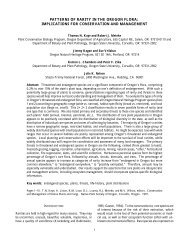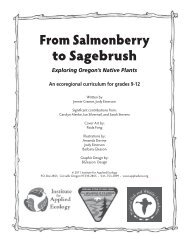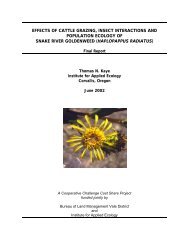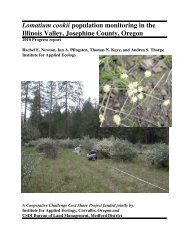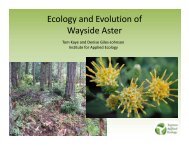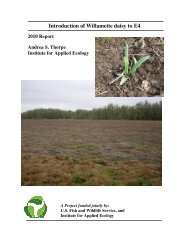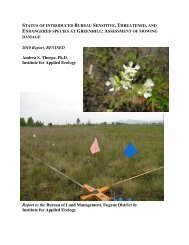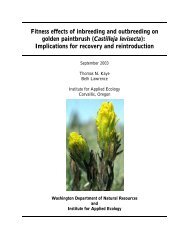Determining appropriate management techniques for Willamette ...
Determining appropriate management techniques for Willamette ...
Determining appropriate management techniques for Willamette ...
Create successful ePaper yourself
Turn your PDF publications into a flip-book with our unique Google optimized e-Paper software.
ERDE Management Progress Report, 2012<br />
Demography and Management of <strong>Willamette</strong> Daisy (Erigeron decumbens)<br />
Figure 8. Ellipse size (cm 2 ) of <strong>Willamette</strong> Daisy at both the Eugene West and Corvallis West REcovery Zones. There was not a significant effect of any<br />
treatment on the size of the plants. As with capitula, the plants from the Corvallis West Recovery zone were consistently larger than those from the<br />
Eugene West Recovery Zoned independent of treatment.<br />
Treatment Effects on Plant Community<br />
The initial site conditions differ between the Corvallis and Eugene sites. Sites at Finley Wildlife Refuge<br />
are dominated by invasive <strong>for</strong>bs whereas sites at Fern Ridge are dominated by invasive grasses. Below<br />
is an average of site conditions across all plots. Data was recorded in the spring of 2012 and here is<br />
presented as an average across all treatment blocks.<br />
The dominant vegetation at Fern Ridge (Eugene West Recovery Zone) is invasive grasses with an average<br />
cover of 61.6% and invasive <strong>for</strong>b cover of 10.4%. Dominant invasive grasses at Fern Ridge include the<br />
perennial species Anthoxanthum odoratum and Agrostis stolonifera each with an average of 30% cover,<br />
additional invasive species include Festuca arundinacea and Panicum occidentale. Annual invasive grasses<br />
at Fern Ridge have very low cover. Native grass cover was only 9.2% with 5.4% represented by<br />
Danthonia cali<strong>for</strong>nica. Average native <strong>for</strong>b cover at Fern Ridge is 5.7% and was dominantly attributed<br />
to Fragaria virginiana and Aster hallii. Invasive <strong>for</strong>b cover has an average of 10.4% cover and is<br />
dominated by Hypochaeris radicata (4.5%), Plantago lanceolata (2%) and Leucanthemum vulgare (1%).<br />
11



